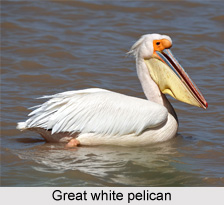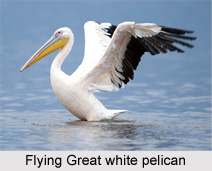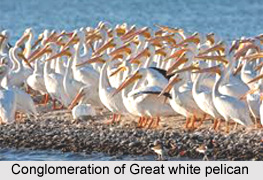 Great White Pelican is an Indian Bird with a scientific name "Pelecanus onocrotalus" also known as the eastern white pelican, rosy pelican or white pelican, named in the pelican family.
Great White Pelican is an Indian Bird with a scientific name "Pelecanus onocrotalus" also known as the eastern white pelican, rosy pelican or white pelican, named in the pelican family.
Breeding of Great White Pelican
Great White Pelican breeds from south-eastern Europe through Asia and in Africa in swamps and shallow lakes.
Structure of Great White Pelican
Great White Pelican is a huge bird, with only the Dalmatian pelican averaging larger amongst the pelicans. The wingspan can range from 226 to 360 centimetres, with the latter measurement the largest recorded among extant flying animals outside the great albatrosses.
Length of Great White Pelican
The total length of Great White Pelican can range from 140 to 180 cm, with the enormous bill comprising 28.9 to 47.1 cm of that length.
Weight of Great White Pelican
The adult male Great White Pelican weights from 9 to 15 kg though large races from the Palaearctic are usually around 11 kg with few exceeding 13 kg. Females are considerably less bulky and heavy, weighing from 5.4 to 9 kg. Among standard measurements, the wing chord length of Great white pelican is 60 to 73 cm, the tail of Great white pelican is 16 to 21 cm and the tarsus of Great white pelican is 13 to 14.9 cm.
Measurement of Great White Pelican
The measurements of Great White Pelican from differing areas indicate that pelicans of this species from the Western Palaearctic are somewhat larger in size than ones that reside in Asia and in Africa.
Immature Great White Pelican
The immature great white pelicans are grey and have dark flight feathers. In flight, it is an elegant soaring bird, with the head held close to and aligned with the body by a downward bend in the neck.
Breeding Condition of Great White Pelican
In breeding condition the male Great white pelican has pinkish skin on its face and the female has orangey skin. It differs from the Dalmatian pelican by its pure white, rather than greyish-white, plumage, a bare pink facial patch around the eye and pinkish legs. The males are larger than females, and have a long beak that grows in a downward arc, as opposed to the shorter, straighter beak of the female. The spot-billed pelican of Asia is slightly smaller than the great white, with clear brownish-grey plumage and a paler, duller-coloured bill. Similarly, the pink-backed pelican is smaller with brownish-grey plumage, with a light pink to off-grey bill and a pinkish wash to the back.
Adaptation of Great White Pelican
Great White Pelican is well adapted for aquatic life. The short strong legs of Great white pelican and webbed feet propel it in water and aid the rather awkward takeoff from the water surface. Once aloft, the long-winged pelicans are powerful fliers, however, and often travel in spectacular V-formation groups
Habitats of Great White Pelican
Great White Pelicans are usually birds found in and around shallow, warm fresh water. Well scattered groups of breeding pelicans occur through Eurasia from the eastern Mediterranean to Vietnam. In Eurasia, fresh or brackish waters may be inhabited and the pelicans may be found in lakes, deltas, lagoons and marshes, usually with dense reed beds nearby for nesting purposes. Additionally, the sedentary populations of Great white pelican are found year-round in Africa, south of the Sahara Desert although these are patchy. In Africa, great white pelicans occur mainly around freshwater and alkaline lakes and may also be found in coastal, estuarine areas.
Migration of Great White Pelican
In the winter months Great White Pelican comes from the Europe and reside in the tropical countries like in north eastern Africa through Iraq to north India, with a particularly large number of breeders from Asia wintering around Pakistan. These are birds that are found mostly in lowlands, though in East Africa and Nepal may be found living at elevations of up to 1,372 m.
 Diet of Great White Pelican
Diet of Great White Pelican
The diet of Great White Pelican consists mainly of fish. The pelicans leave their roost to feed early in the mornings and may fly over 100 km in search of food, as has been observed in Chad and Mogode, Cameroon. Each pelican needs from 0.9 to 1.4 kg of fish every day. This corresponds to around 28,000,000 kg of fish consumed every year at the largest colony of great white pelicans, on Tanzania`s Lake Rukwa by almost 75,000 birds.
Breeding Season of Great White Pelican
Breeding season of Great white pelican commences in April or May in temperate zones, essentially all year around in Africa and begins in February through April in India. Large numbers of these pelicans breed together in colonies. The female can lay from 1 to 4 eggs in a clutch, with two being the average.
Nests of Great White Pelican
The nest locations of Great White Pelican are variable. Some populations making stick nests in trees but a majority, including all those who breed in Africa, nest exclusively in scrapes on the ground lined with grass, sticks, feathers and other material. The young are cared by both parents. The incubation stage lasts for 29 to 36 days. The chicks are naked when they hatch but quickly sprout blackish-brown down. The colony gathers in "pods" around 20 to 25 days after the eggs hatch. The young fledge at 65 to 75 days of age. Around 64% of young successful reach adulthood, with sexual maturity attained at 3 to 4 years of age. White pelicans are often protected from bird-eating raptors by virtue of their own great size, but eagles, especially sympatric Haliaeetus species, may predate their eggs, nestlings and fledglings. Occasionally, pelicans and their young are attacked at their colonies by mammalian carnivores from jackals to lions. As is common in pelicans, the close approach of a large predaceous or unknown mammal, including a human, at a colony will lead the pelican to abandon their nest in self-preservation.











